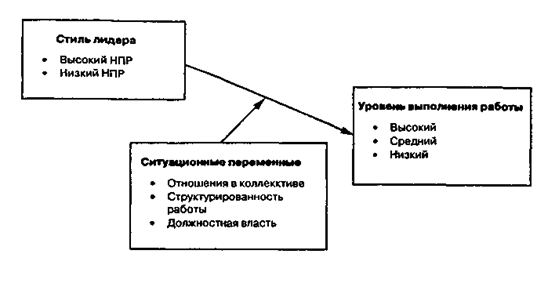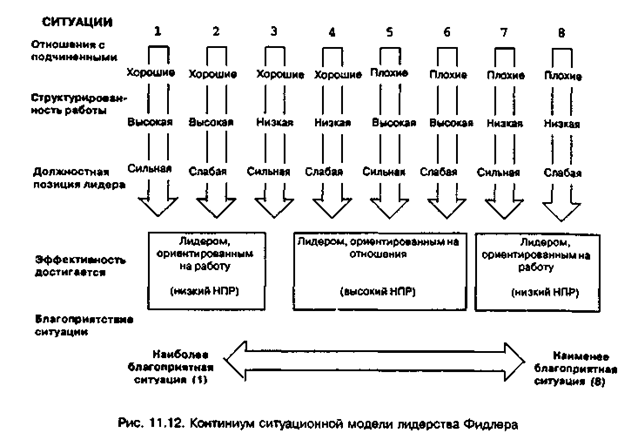home
 Management Management
 Management - Vikhansky OS Management - Vikhansky OS
|
Management - Vikhansky OS
3.2. Model of situational leadership Fiedler
Fred Fiedler rightly considered the founder of situational leadership theory [4]. His model, work on which he started in the mid 60-ies., Allows us to predict the effectiveness of the working group, led by the leader. The model uses three situational variables, making it possible to determine the degree of favorability or controllability of the situation for a particular leadership style.
In order to measure and determine the leadership style Fiedler suggested using a scale developed by the characteristics of their least-preferred employee (NDP). According to this scale, respondents noting points in each of the scale positions must describe a hypothetical person with whom they could work the least successful. An example of the individual items of the scale vosmiballnoy given below.
Nedruzhestven 1 2 3 4 5 6 7
Pleasant 8 7 6 5 4 3 2
All rejects 1 2 3 4 5 6 7
Tense 1 2 3 4 5 6 7
After the scores are calculated for all positions of the scale is determined by the leader's style. So, the leaders of respondents who received higher scores, ie, describe your PND is very positive, have a style-oriented attitude, and scored lower scores - have a style that focuses on the work. Accordingly, these two types of leaders became known as the leader of the NDP, and high leader low NDP. According to the findings Fiedler, leadership style has remained relatively constant and almost does not change from situation to situation, as reflected in the style of the individual foundations of motivation: motivation in the attitude and motivation to work.
Controlled or determined by a favorable situation in the model as the degree to which the situation allows the leader to control it and influence followers. This degree can be high or low. In the first case it is expected that the leader solutions give predictable results as it has the ability to influence the outcome. In the second case, the leader of solutions can not lead to the desired results.
The degree of control of the situation in the model is determined by the following three variables.
Relationship "leader - followers". This variable reflects the level of loyalty, trust, support and respect, tested and exhibited a follower with respect to the leader. It is a recognition of the leader of the followers of that is the most important condition for gaining control over the situation. Taking the leader, the followers will do everything possible to achieve their goals.
Structure the work. This variable reflects the level of structuring group solved the problems or tasks performed by it and it is measured by the following components:
• clarity of purpose - the degree to which the problem or task clearly formulated or delivered and familiar performers;
• multiplicity of means to achieve the goal - the degree of the possibility of using various ways and means of achieving the goal;
• validity of the decision - the degree of "correctness" of the decision, confirmed by the level of his decision, his logic or results.
• specificity of solutions - the extent possible the adoption of alternative solutions.
As highly structured work itself contains instructions what to do, the leader gets in this situation more control over performers.
The duty power. Considered variable reflects the level of the leader of the formal power, it receives on the basis of occupied positions in the organization, in particular, the adequacy of formal authority to adequately reward or punish subordinates to improve their position or dismiss.
Fig. 11.11 shows a schematic diagram of the interaction of leadership style to situational variables.
effective leadership model is based on the fact that situational leadership. The favorable situation in relation to the particular style is determined by three variables previously discussed: the level of relations, structured work and leadership power. This means that leadership effectiveness depends on how the situation gives the leader the ability to influence others.

Fig. 11.11. Situational variables Fiedler model
Three situational variables in conjunction with the two leadership styles give eight types of situations (Fig. 11.12), clearly describing the model of Fiedler. Leaders with low NDP may be more effective than their counterparts with high PND, in situations most favored] 1- 3, and - at the least favorable conditions 8. This is due to, for example, the fact that, being motivated mainly on vyponenie work / jobs, they in a situation 1budut seek to establish good relations to work with their subordinates. At the same time they take into account the favorable situation and high predictability in the performance of work / job. Thus there is a situation in which they can focus more on the improvement of relations with subordinates, instead of interfering in their work. Workers usually like it, and they try to work well. In the least favorable situation 8, the same leaders will strive to achieve organizational goals by interfering with the work of subordinates, telling them what to do.
Fig. 11.12 also shows the situation in which the leader of the NDP high, it may be more effective than leading low NDP. The leader of the high-NDP does best in a moderately positive (situation 4 - 7). Situations 4 and 5 represent cases where the followers operate structured task, but at the same time have the best relationship with the leader. Accordingly, in these circumstances, the leader has to take an interest in emotion subordinates. There's also a different situation when the leader adore, but the job is poorly structured. In this case, the leader is dependent on the presence of the followers of desire and creativity to the task. Therefore, it is necessary to transfer the focus from relationships to work as such.
In Fiedler's model, there are a number of uncertainties. The first refers to the level of measurement accuracy and completeness of leadership style with the help of indicators NDP is supposed to do it in one-dimensional space. It is questionable statement Fiedler on the relative constancy of the value of CPD over time, its low exposure to changes. The model also does not offer to search for the effectiveness of the leader on two fronts: relationships and work. However, in spite of these observations, a model commonly used in solving the problems lead to organizations.

The use of this model is carried out in the following areas. The model allows to choose the head in accordance with the current situation in the organization or group. The model also suggests the way to change the situation, if you can not, for whatever reasons, to replace the head. In the end, the head itself can do something to change the situation in their favor. Such measures are discussed below:
Changing the level of relations with subordinates
1. More (or less) to spend their time on non-formal communication with subordinates (lunch, sports, etc.)
2. Choose the right people themselves
3. Identify mentors to those in whom we are not sure
4. To raise morale among employees, achieving tangible results
Changing the level of structuring work
If one wants to have a less structured work:
1. asked for the difficult and unusual assignment
2. Pass on the part of the slave-making work
In the case of the desire to have a more structured work.
1. Enlist the instructions over
2. Divide the work into smaller and structured parts or stages
Changes in the level of positional power in the organization
The upward:
1. Using all the available power to show the subordinate who is who
2. Provide information to obtain followers only through you
The downward:
1. To encourage subordinates to participate in the management of
2. Delegate authority of the Deputy and Assistant
The model provides a basis for the assertion that the head, despite the fact that it is very difficult, it is possible to teach how to become an effective leader. It is much more difficult than to change the situation in which the leader. However, according to Fiedler, through training and experience it is still possible to improve the leader's ability to use the power and influence under the conditions best favored. This means that the training program can be useful to the leader-centered attitude. But, at the same time, it can cause harm to the leader-oriented work.


Comments
Commenting, keep in mind that the content and the tone of your messages can hurt the feelings of real people, show respect and tolerance to his interlocutors, even if you do not share their opinion, your behavior in terms of freedom of speech and anonymity offered by the Internet, is changing not only virtual, but real world. All comments are hidden from the index, spam control.